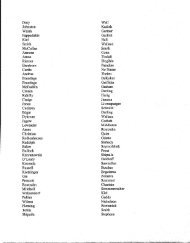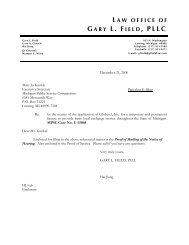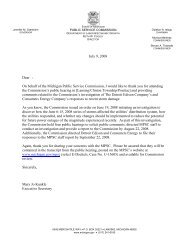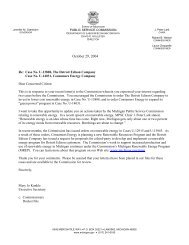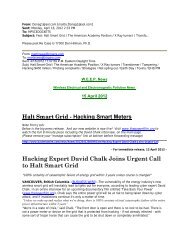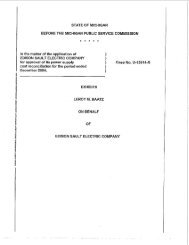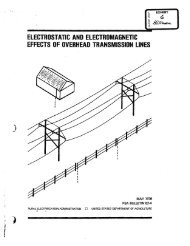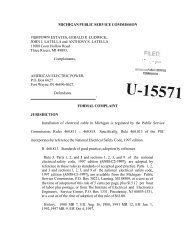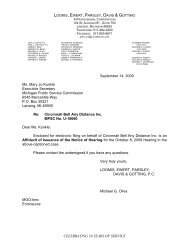Direct Testimony of James T. Selecky On Behalf of ABATE
Direct Testimony of James T. Selecky On Behalf of ABATE
Direct Testimony of James T. Selecky On Behalf of ABATE
Create successful ePaper yourself
Turn your PDF publications into a flip-book with our unique Google optimized e-Paper software.
Before the<br />
Public Service Commission<br />
<strong>of</strong> the State <strong>of</strong> Michigan<br />
Case No. U-12639<br />
<strong>Direct</strong> <strong>Testimony</strong> <strong>of</strong><br />
<strong>James</strong> T. <strong>Selecky</strong><br />
<strong>On</strong> <strong>Behalf</strong> <strong>of</strong><br />
<strong>ABATE</strong><br />
May 2001<br />
Project 7414
1<br />
2<br />
3<br />
4<br />
5<br />
6<br />
7<br />
8<br />
9<br />
10<br />
11<br />
12<br />
INTRODUCTION<br />
Before the<br />
Public Service Commission <strong>of</strong> the State <strong>of</strong> Michigan<br />
Case No. U-12639<br />
<strong>Direct</strong> <strong>Testimony</strong> <strong>of</strong> <strong>James</strong> T. <strong>Selecky</strong><br />
Q PLEASE STATE YOUR NAME AND BUSINESS ADDRESS.<br />
A <strong>James</strong> T. <strong>Selecky</strong>; 1215 Fern Ridge Parkway, Suite 208; St. Louis, Missouri, 63141.<br />
Q WHAT IS YOUR OCCUPATION AND BY WHOM ARE YOU EMPLOYED?<br />
A I am a consultant in the field <strong>of</strong> public utility regulation and a principal in the firm <strong>of</strong><br />
Brubaker & Associates, Inc., energy, economic and regulatory consultants.<br />
Q PLEASE STATE YOUR EDUCATIONAL BACKGROUND AND EXPERIENCE.<br />
A These are set forth in Appendix A to this testimony.<br />
Q ON WHOSE BEHALF ARE YOU TESTIFYING IN THIS PROCEEDING?<br />
A I am presenting testimony on behalf <strong>of</strong> the Association <strong>of</strong> Businesses Advocating<br />
Tariff Equity (<strong>ABATE</strong>). Member companies <strong>of</strong> <strong>ABATE</strong> are substantial purchasers <strong>of</strong><br />
electricity from The Detroit Edison Company (DECo or Company).<br />
BRUBAKER & ASSOCIATES, INC.
1<br />
2<br />
3<br />
4<br />
5<br />
6<br />
7<br />
8<br />
9<br />
10<br />
11<br />
12<br />
13<br />
14<br />
15<br />
16<br />
17<br />
18<br />
19<br />
20<br />
21<br />
22<br />
23<br />
24<br />
BRUBAKER & ASSOCIATES, INC.<br />
<strong>James</strong> T. <strong>Selecky</strong><br />
Page 2<br />
Q HAVE YOU PRESENTED TESTIMONY IN PRIOR DECo PROCEEDINGS BEFORE<br />
THE MICHIGAN PUBLIC SERVICE COMMISSION (COMMISSION OR MPSC)?<br />
A Yes. I have been involved in many prior DECo proceedings before this Commission.<br />
Q WHAT ISSUES ARE BEING ADDRESSED IN YOUR TESTIMONY?<br />
A My testimony addresses the level <strong>of</strong> net stranded cost appropriate for DECo and the<br />
development <strong>of</strong> a net stranded cost credit or negative surcharge. I will also discuss<br />
DECo’s method for calculating its net stranded cost and DECo’s proposed<br />
Equalization Transition Charge Adjustment (ETCA).<br />
SUMMARY OF CONCLUSIONS AND RECOMMENDATIONS<br />
Q PLEASE SUMMARIZE YOUR CONCLUSIONS AND RECOMMENDATIONS OF<br />
YOUR TESTIMONY.<br />
A The summary <strong>of</strong> my conclusions and recommendations is listed below:<br />
1. DECo’s net stranded costs are negative. That is, DECo’s net stranded benefits<br />
exceed its net stranded costs.<br />
2. The Commission should establish a net stranded cost credit or negative<br />
surcharge.<br />
3. The net stranded cost credit would only apply to customers who participate in the<br />
open access program.<br />
4. The Commission should reject DECo’s method for calculating net stranded cost<br />
because it will not promote open access.<br />
5. DECo’s ETCA should be rejected because it is inconsistent with Public Act 141<br />
(Act 141) in that it violates the rate freeze provisions. DECo’s ETCA requires the<br />
commercial secondary and industrial/commercial primary customers to continue<br />
to subsidize the residential customers in the open market.
1<br />
2<br />
3<br />
4<br />
5<br />
6<br />
7<br />
8<br />
9<br />
10<br />
11<br />
12<br />
13<br />
14<br />
15<br />
16<br />
17<br />
18<br />
19<br />
20<br />
21<br />
22<br />
23<br />
24<br />
LEVEL OF NET STRANDED COST<br />
BRUBAKER & ASSOCIATES, INC.<br />
<strong>James</strong> T. <strong>Selecky</strong><br />
Page 3<br />
Q HAS <strong>ABATE</strong> FILED EVIDENCE ADDRESSING THE APPROPRIATE LEVEL OF<br />
NET STRANDED COST?<br />
A Yes. <strong>ABATE</strong> has filed evidence to assist the Commission in its mandate to determine<br />
the net stranded costs for DECo. <strong>ABATE</strong> witness Christopher Seiple <strong>of</strong> RDI<br />
Consulting, a division <strong>of</strong> Financial Times Energy, using a discounted cash flow<br />
approach, concludes that DECo’s generating assets have a market value <strong>of</strong> at least<br />
$5.702 billion, and a net book value, excluding Fermi 2, <strong>of</strong> $2.565 billion at December<br />
31, 2000. This results in a net stranded benefit <strong>of</strong> more than $3.137 billion. Factoring<br />
in the Commission’s Case No. U-12478 net book cost <strong>of</strong> $2.333 billion for Fermi 2<br />
and the net stranded costs associated with power purchase and power sales<br />
contracts reduces the net stranded benefit to $0.760 billion. That is, DECo does not<br />
have any stranded costs.<br />
In addition, <strong>ABATE</strong> witness Dr. Richard Tabors, using a comparative<br />
generation sales analysis, concludes that DECo’s generating units have a market<br />
value <strong>of</strong> $5.724 billion, and net book value <strong>of</strong> $4.898 billion including Fermi 2. This<br />
results in a net stranded benefit <strong>of</strong> $0.826 billion for generating assets owned by<br />
DECo.<br />
Q SHOULD THE COMMISSION UTILIZE THESE ESTIMATES TO DETERMINE THE<br />
LEVEL OF DECo’S NET STRANDED COSTS?<br />
A Yes. To meet the requirements <strong>of</strong> Section 10a. (10) <strong>of</strong> the June 5, 2000 Act 141, the<br />
Commission should rely on the <strong>ABATE</strong> estimates <strong>of</strong> net stranded costs. The<br />
methods put forth by <strong>ABATE</strong> clearly address the methods the Commission needs to<br />
consider in determining DECo’s stranded cost.
1<br />
2<br />
3<br />
4<br />
5<br />
6<br />
7<br />
8<br />
9<br />
10<br />
11<br />
12<br />
13<br />
14<br />
15<br />
16<br />
17<br />
18<br />
19<br />
20<br />
21<br />
22<br />
23<br />
24<br />
25<br />
26<br />
27<br />
BRUBAKER & ASSOCIATES, INC.<br />
<strong>James</strong> T. <strong>Selecky</strong><br />
Page 4<br />
<strong>ABATE</strong> consultants have used two different administrative valuation<br />
approaches to calculate stranded costs. As indicated above, both approaches<br />
produced similar results. The fact that Dr. Tabors’ estimate produces a slightly higher<br />
market value for DECo’s generating assets is not surprising. As indicated in the<br />
testimony <strong>of</strong> Mr. Seiple <strong>of</strong> RDI, he would expect the actual sale <strong>of</strong> the assets to yield<br />
a higher market value. Mr. Tabors’ analysis, which is a comparative generation sales<br />
analysis, captures some <strong>of</strong> the sources <strong>of</strong> value that would be present in a true<br />
auction that are not captured by Mr. Seiple’s analysis.<br />
Q SHOULD THE COMMISSION DEVELOP A STRANDED BENEFIT SURCHARGE?<br />
A Yes. The Commission should develop a stranded benefit credit or negative<br />
surcharge that would be applicable to customers that participate in the customer<br />
choice or open access program. This stranded benefit credit would be an <strong>of</strong>fset or<br />
reduction to the securitization charge that results from the Commission’s order in<br />
Case No. U-12478.<br />
Q HAVE DECo’S SECURITIZATION CHARGES BEEN ESTABLISHED?<br />
A Yes. <strong>On</strong> March 16, 2001, DECo filed a letter with the Commission indicating the<br />
following:<br />
“Using the formula approved by the Commission in the Financing<br />
Order, this filing establishes the variables used in the calculation <strong>of</strong> the<br />
initial SB Charge and provides the resulting SB Charge and SB Tax<br />
Charge. Attachment A shows the values for each <strong>of</strong> the variables<br />
used in calculating the initial SB Charge and SB Tax Charge which is<br />
3.2 (mills/kWh) and 0.5 (mills/kWh) respectively. It is anticipated that<br />
the SB Charge and SB Tax Charge will be in effect from March 26,<br />
2001 through February 28, 2002 at which time the charges may be<br />
modified pursuant to the true-up procedures established in the<br />
Financing Order.”
1<br />
2<br />
3<br />
4<br />
5<br />
6<br />
7<br />
8<br />
9<br />
10<br />
11<br />
12<br />
13<br />
14<br />
15<br />
16<br />
17<br />
18<br />
19<br />
20<br />
21<br />
22<br />
23<br />
24<br />
25<br />
26<br />
27<br />
28<br />
29<br />
BRUBAKER & ASSOCIATES, INC.<br />
<strong>James</strong> T. <strong>Selecky</strong><br />
Page 5<br />
These two charges produce a total securitization charge <strong>of</strong> .37¢ per kWh that<br />
will recover DECo’s stranded costs, which include Fermi 2 and various other<br />
regulatory assets net <strong>of</strong> certain regulatory liabilities.<br />
Q WHY SHOULD THE COMMISSION ESTABLISH A STRANDED BENEFIT CREDIT?<br />
A Without this determination, the purposes <strong>of</strong> Act 141, which was to create customer<br />
choice for DECo customers, will not be met. Specifically, Section 10 <strong>of</strong> Act 141 states<br />
the purposes <strong>of</strong> this recently passed legislation. The stated purposes are:<br />
“(a) To ensure that all retail customers in this state <strong>of</strong> electric power<br />
have a choice <strong>of</strong> electric suppliers.<br />
(b) To allow and encourage the Michigan public service commission to<br />
foster competition in this state in the provision <strong>of</strong> electric supply and<br />
maintain regulation <strong>of</strong> electric supply for customers who continue to<br />
choose supply from incumbent electric utilities.<br />
(c) To encourage the development and construction <strong>of</strong> merchant<br />
plants which will diversify the ownership <strong>of</strong> electric generation in this<br />
state.<br />
(d) To ensure that all persons in this state are afforded safe, reliable<br />
electric power at a reasonable rate.<br />
(e) To improve the opportunities for economic development in this<br />
state and to promote financially healthy and competitive utilities in this<br />
state.” (Public Act No. 141 <strong>of</strong> 2000, Sec. 10 (2))<br />
The Commission has authorized DECo to securitize $1.750 billion <strong>of</strong> costs. It<br />
is implied that a significant portion <strong>of</strong> those costs is stranded and DECo would not be<br />
able to collect those costs in a competitive market. If the Commission does not<br />
establish a credit to recognize DECo’s stranded benefits and DECo’s securitization<br />
charges as authorized remain in place, the development <strong>of</strong> a competitive electric<br />
utility market would be severely impeded. Assessing DECo’s customers that<br />
participate in the customer choice program, a charge that only recognizes claimed<br />
stranded costs would have an adverse effect on the ability <strong>of</strong> customers to use open
1<br />
2<br />
3<br />
4<br />
5<br />
6<br />
7<br />
8<br />
9<br />
10<br />
11<br />
12<br />
13<br />
14<br />
15<br />
16<br />
17<br />
18<br />
19<br />
20<br />
21<br />
22<br />
23<br />
24<br />
25<br />
26<br />
27<br />
28<br />
29<br />
30<br />
31<br />
32<br />
33<br />
34<br />
35<br />
BRUBAKER & ASSOCIATES, INC.<br />
<strong>James</strong> T. <strong>Selecky</strong><br />
Page 6<br />
access service and the development <strong>of</strong> merchant plants that are needed to provide<br />
the State with future capacity additions to provide a reliable source <strong>of</strong> electricity.<br />
Q WHAT IS THE BASIS FOR YOUR STATEMENT THAT DECo’S PROPOSED<br />
LEVEL OF STRANDED COSTS WOULD IMPEDE COMPETITION AND THE<br />
DEVELOPMENT OF MERCHANT PLANTS IN THE STATE OF MICHIGAN?<br />
A In a report, the Commission had the following comment regarding an electric industry<br />
restructuring proposal:<br />
“The Commission has thoroughly examined the Electric Industry<br />
Restructuring Proposal put forth by the Chamber <strong>of</strong> Commerce and<br />
Consumers Energy Company, which has subsequently been amended<br />
by a number <strong>of</strong> other parties. The Commission has also examined the<br />
proposal put forth by Detroit Edison. The Commission has two<br />
concerns over the transition charge in the Chamber-Consumers<br />
Energy proposal, as amended by Detroit Edison. These concerns are:<br />
(1) the transition charge is too large and will thus preclude effective<br />
competition, and (2) the transition charge will continue for 15 years for<br />
Detroit Edison, and 25 years for Consumers Energy, thus locking in<br />
Michigan to a no-competition or limited competition mode while most,<br />
or all other states, will pass us by competitively.<br />
It is estimated that the transition charge for customers in<br />
Consumers Energy’s territory will be between 6 and 7 mills (0.6 to 0.7<br />
cents) while the transition charge for customers in Detroit Edison’s<br />
territory will be approximately 3.5 mills (0.35 cents). These charges,<br />
which cannot be adjusted by the Michigan Public Service Commission<br />
even if they prove unworkable, will remain until they expire. The<br />
Commission believes that a transition charge <strong>of</strong> 3 mills (0.3 cents) is<br />
the maximum charge in which to foster a competitive market. This is<br />
usually a number given by most customer groups and potential<br />
competitors.”<br />
As previously stated, DECo’s securitization charge will be 3.7 mills per kWh or<br />
0.37¢ per kWh. Based on the above quote, it is likely that the stated purposes <strong>of</strong> Act<br />
141 will not be met, i.e., a competitive electric market will not develop. Without this<br />
market, the development and construction <strong>of</strong> merchant plants will be severely<br />
hindered because it will not be economical for buyers and sellers to participate in the<br />
open access market.
1<br />
2<br />
3<br />
4<br />
5<br />
6<br />
7<br />
8<br />
9<br />
10<br />
11<br />
12<br />
13<br />
14<br />
15<br />
16<br />
17<br />
18<br />
19<br />
20<br />
21<br />
22<br />
BRUBAKER & ASSOCIATES, INC.<br />
<strong>James</strong> T. <strong>Selecky</strong><br />
Page 7<br />
Q HAVE YOU DEVELOPED A STRANDED BENEFIT CREDIT OR NEGATIVE<br />
SURCHARGE THAT WOULD BE APPLICABLE TO ALL CUSTOMERS THAT<br />
PARTICIPATE IN THE CUSTOMER CHOICE PROGRAM?<br />
A Yes. I have developed a stranded benefit credit using the same rate design that the<br />
Commission authorized DECo in Case No. U-12478, to collect its securitized cost. In<br />
that case, DECo is authorized to apply a uniform securitization surcharge per kWh to<br />
all metered customers. In this case, I am proposing that a stranded benefit credit or<br />
negative surcharge <strong>of</strong> 4.18 mills per kWh be assessed to all customers that<br />
participate in the open access program.<br />
Because DECo is obligated to serve bundled customers, the stranded benefit<br />
credit will not be applied to their usage. Although a bundled customer pays the<br />
securitization charges, their base energy charge is reduced by an equal amount.<br />
Therefore, the securitization charge does not currently adversely affect their power<br />
costs.<br />
Q HOW DID YOU DEVELOP YOUR PROPOSED STRANDED BENEFIT CREDIT?<br />
A My stranded benefit credit was developed from comparing the costs that DECo will<br />
securitize with the results <strong>of</strong> the net stranded cost analyses presented in this<br />
proceeding by <strong>ABATE</strong> witnesses.<br />
Q WOULD YOU PLEASE SUMMARIZE THE COST THAT DECo WILL SECURITIZE?<br />
A <strong>On</strong> April 9, 2001, DECo supplied to the Commission a 30-day securitization report. In<br />
that report, DECo indicated that it would securitize $1.750 billion <strong>of</strong> cost net <strong>of</strong> tax.<br />
Table 1 below summarizes those costs on a before tax and net <strong>of</strong> tax basis.
1<br />
2<br />
3<br />
4<br />
5<br />
6<br />
7<br />
8<br />
9<br />
10<br />
11<br />
12<br />
TABLE 1<br />
DECo’s Securitized Costs<br />
Before Tax Cost Net <strong>of</strong> Tax Cost<br />
Description<br />
($Million)<br />
($Million)<br />
Fermi 2 $2,273 $1,478<br />
Reacquired Debt 63 41<br />
FAS 109 156 101<br />
FAS 106 82 54<br />
Implementation 30 19<br />
Issuing Costs 30 20<br />
Retiring Securities 58 38<br />
Total<br />
$2,692 $1,750<br />
Total w/o Fermi 2<br />
BRUBAKER & ASSOCIATES, INC.<br />
$ 419 $ 272<br />
<strong>James</strong> T. <strong>Selecky</strong><br />
Page 8<br />
As Table 1 above shows, excluding Fermi 2, the Commission authorized<br />
DECo to securitize $419 million <strong>of</strong> costs.<br />
Q WHAT DO THE <strong>ABATE</strong> ANALYSES SHOW RELATIVE TO DECo’S NET<br />
STRANDED COSTS?<br />
A The <strong>ABATE</strong> analyses show that DECo has net stranded benefits. That is, the<br />
stranded benefits associated with its generating assets and power purchase and<br />
power sales contracts exceed its stranded cost.<br />
<strong>ABATE</strong> witness Christopher Seiple’s analysis shows that DECo has net<br />
stranded benefits from power purchase and power sales obligations and generating<br />
assets <strong>of</strong> $3.093 billion, excluding the net book value <strong>of</strong> Fermi 2. Factoring in the net<br />
book value <strong>of</strong> Fermi 2 produces a net benefit <strong>of</strong> $760 million. A summary <strong>of</strong> Mr.<br />
Seiple’s analysis is shown in Table 2 below.
1<br />
2<br />
3<br />
4<br />
5<br />
6<br />
TABLE 2<br />
Christopher Seiple Analysis<br />
Description<br />
BRUBAKER & ASSOCIATES, INC.<br />
Net Benefit<br />
($Million)<br />
Steam $3,294<br />
Pump Storage (51)<br />
Gas Turbines (106)<br />
Power Purchases (44)<br />
Subtotal<br />
$3,093<br />
Fermi 2<br />
Total<br />
($2,333)<br />
$ 760<br />
<strong>James</strong> T. <strong>Selecky</strong><br />
Page 9<br />
<strong>ABATE</strong> witness Dr. Richard Tabors provided an analysis that determined<br />
DECo’s net stranded costs to be a negative $826 million. DECo’s stranded benefit<br />
exceeds its stranded cost. Since Dr. Tabors’ analysis did not reflect any net stranded<br />
costs associated with DECo’s power purchase and power sales obligations, I have<br />
utilized the results <strong>of</strong> the power purchase analysis performed by Mr. Seiple, and<br />
included that in Dr. Tabors’ analysis. The results are shown below in Table 3.<br />
TABLE 3<br />
Richard Tabors Analysis<br />
Comparable Book Net<br />
Value Value Benefit<br />
Description ($Million) ($Million) ($Million)<br />
Generation $5,724 $4,898 $826<br />
Power Purchases – – ($44)<br />
Total<br />
$782
1<br />
2<br />
3<br />
4<br />
5<br />
6<br />
7<br />
8<br />
9<br />
10<br />
11<br />
12<br />
13<br />
14<br />
15<br />
16<br />
17<br />
18<br />
19<br />
20<br />
21<br />
22<br />
23<br />
BRUBAKER & ASSOCIATES, INC.<br />
<strong>James</strong> T. <strong>Selecky</strong><br />
Page 10<br />
As Table 3 shows, DECo has net stranded benefits <strong>of</strong> $782 million, including<br />
power purchase obligations.<br />
Q HOW DID YOU UTILIZE THE RESULTS OF <strong>ABATE</strong> ANALYSES TO DEVELOP A<br />
STRANDED BENEFIT CREDIT?<br />
A As Table 1 shows, the Commission authorized DECo to securitize costs, excluding<br />
Fermi 2, <strong>of</strong> approximately $419 million. The analyses performed by <strong>ABATE</strong><br />
witnesses shown in Tables 2 and 3 indicate that including Fermi 2 costs, DECo has<br />
net stranded benefits <strong>of</strong> $760 million and $782 million, respectively. That is, using the<br />
results <strong>of</strong> these analyses, the average net stranded benefit for DECo is $771 million.<br />
These net benefits can be used to <strong>of</strong>fset DECo’s stranded net regulatory asset cost,<br />
excluding Fermi 2. Fermi 2 is excluded because it is included in the development <strong>of</strong><br />
the net stranded costs <strong>of</strong> DECo’s generation assets as determined by the <strong>ABATE</strong><br />
witnesses.<br />
This average net benefit <strong>of</strong> $771 million <strong>of</strong>fsets DECo’s securitized net<br />
regulatory costs, excluding Fermi 2, <strong>of</strong> $419 million (see Table 1). This results in<br />
DECo having net generation-related benefits <strong>of</strong> $352 million ($771 million - $419<br />
million) greater than the costs, excluding Fermi 2 that the Commission authorized<br />
DECo to securitize. Therefore, DECo’s net stranded benefit credit should be larger<br />
than DECo’s proposed securitization surcharge.<br />
Q HOW DID YOU DEVELOP A SPECIFIC STRANDED BENEFIT SURCHARGE?<br />
A As indicated in the previous answer, DECo’s net benefits associated with its<br />
generation assets are $352 million greater than the costs that DECo is authorized to<br />
securitize. As indicated in Table 1, DECo is authorized to securitize costs before its
1<br />
2<br />
3<br />
4<br />
5<br />
6<br />
7<br />
8<br />
9<br />
10<br />
11<br />
12<br />
13<br />
14<br />
15<br />
16<br />
17<br />
18<br />
19<br />
BRUBAKER & ASSOCIATES, INC.<br />
<strong>James</strong> T. <strong>Selecky</strong><br />
Page 11<br />
net <strong>of</strong> tax adjustment <strong>of</strong> $2,692 million. Since the net benefits produced by the<br />
<strong>ABATE</strong> analyses are 13.1% greater than DECo’s proposed securitized costs, I<br />
recommend that the net benefit credit be 13.1% greater than the securitization<br />
surcharge. Therefore, if the securitization surcharge is 3.7 mills per kWh for DECo,<br />
the net benefit credit should be 4.18 mills per kWh. It should be remembered that the<br />
net benefit credit is a negative surcharge and is only applicable to those customers<br />
who participate in the open access program.<br />
Alternatively, the Commission could implement a stranded benefit credit equal<br />
to the securitization surcharge. The $352 million <strong>of</strong> net stranded benefits that is not<br />
included in the credit would be used to <strong>of</strong>fset future implementation costs. However,<br />
in the event that the available net stranded benefits exceed the implementation costs,<br />
any excess should be fed back to the customers.<br />
Q DO YOU HAVE ANY COMMENTS TO MAKE REGARDING THE DEVELOPMENT<br />
OF A STRANDED BENEFIT CREDIT?<br />
A Yes. If the Commission, in the unbundling case to be filed, requires that a<br />
securitization surcharge be developed separately for each rate class, a similar<br />
approach has to be taken for the development <strong>of</strong> the stranded benefit credit.<br />
However, the same approach that is used to develop the securitization surcharge<br />
should also be used to develop the stranded benefit credit.
1<br />
2<br />
3<br />
4<br />
5<br />
6<br />
7<br />
8<br />
9<br />
10<br />
11<br />
12<br />
13<br />
14<br />
BRUBAKER & ASSOCIATES, INC.<br />
<strong>James</strong> T. <strong>Selecky</strong><br />
Page 12<br />
Q AS A RESULT OF SECURITIZATION, WILL DECo HAVE ANY EXCESS<br />
SECURITIZATION SAVINGS AFTER FUNDING THE 5% RATE REDUCTIONS AND<br />
THE LOW INCOME ENERGY FUND?<br />
A Yes. DECo witness Van Haerents indicates in response to discovery question EMDE<br />
4.22/129 that DECo will have the following annual amounts in excess <strong>of</strong> the 5% rate<br />
reduction and low income and energy efficiency fund:<br />
TABLE 4<br />
Excess Securitization Savings<br />
Year<br />
Amount<br />
(000)<br />
2002 $82,976<br />
2003 $30,249<br />
2004 $28,141<br />
2005 $20,455<br />
2006 $ 8,726<br />
2007 $ 554<br />
2008 $44,092<br />
Q HOW SHOULD THESE FUNDS BE UTILIZED?<br />
A These funds should be utilized to either reduce stranded cost or reasonable<br />
implementation costs related to customer choice. This is consistent with Act 141 <strong>of</strong><br />
2000 and the Commission’s Orders in Case No. U-12478.<br />
DECo should be required to create a separate account to record these excess<br />
securitization savings on an annual basis along with interest or a carrying charge.<br />
The use <strong>of</strong> the funds would be addressed in the annual true-up proceedings. Finally,<br />
if the retail access program is unsuccessful, the excess securitization savings should
1<br />
2<br />
3<br />
4<br />
5<br />
6<br />
7<br />
8<br />
9<br />
10<br />
11<br />
12<br />
13<br />
14<br />
15<br />
16<br />
17<br />
18<br />
19<br />
20<br />
21<br />
22<br />
BRUBAKER & ASSOCIATES, INC.<br />
<strong>James</strong> T. <strong>Selecky</strong><br />
Page 13<br />
be passed on to the ratepayers in the form <strong>of</strong> a permanent rate reduction and any<br />
unrecovered implementation costs should be disallowed.<br />
Q IS THERE ANY OTHER SOURCE OF REVENUES THAT SHOULD BE USED TO<br />
OFFSET STRANDED COSTS?<br />
A Yes. As a result <strong>of</strong> DECo’s securitization, for a period <strong>of</strong> six years approximately $50<br />
million per year <strong>of</strong> the reduction in DECo’s revenue requirement associated with<br />
securitization is allocated to the low-income and energy efficiency fund administered<br />
by the MPSC. At the end <strong>of</strong> the six-year period, these funds should be used to further<br />
reduce stranded cost. It is my understanding that the MPSC has not previously<br />
addressed the disposition <strong>of</strong> these funds at the end <strong>of</strong> the six-year period.<br />
DECo’S POSITION<br />
Q BEFORE YOU DISCUSS DECo’S PROPOSAL FOR CALCULATING NET<br />
STRANDED COSTS, WHAT IS MEANT BY THE TERM “NET STRANDED COST”?<br />
A Generally, the term refers to costs that are permitted to be collected from customers<br />
under regulation, but cannot be recovered in a competitive market. <strong>ABATE</strong> witness<br />
Mr. Phillips addresses the term “net stranded cost” in detail in his prefiled testimony.<br />
Q HAS DECo PROVIDED A METHOD FOR RECOVERING ITS CLAIMED NET<br />
STRANDED COST?<br />
A DECo has proposed a method for recovering what it defines as net stranded cost.<br />
Under DECo’s definition, net stranded cost is the net economic harm or benefit<br />
experienced by DECo as a result <strong>of</strong> customers participating in the retail electric<br />
choice program. That is, if a customer chooses to take generation service from an
1<br />
2<br />
3<br />
4<br />
5<br />
6<br />
7<br />
8<br />
9<br />
10<br />
11<br />
12<br />
13<br />
14<br />
15<br />
16<br />
17<br />
18<br />
19<br />
20<br />
21<br />
22<br />
23<br />
BRUBAKER & ASSOCIATES, INC.<br />
<strong>James</strong> T. <strong>Selecky</strong><br />
Page 14<br />
alternate provider, DECo experiences harm in the form <strong>of</strong> lost revenues. DECo<br />
receives <strong>of</strong>fsetting benefits if it can sell the freed-up power to the market. Simply put,<br />
the difference between the lost revenues and the revenues received by <strong>of</strong>f-system<br />
sales produces DECo’s net stranded cost. DECo witness A. Zakem describes in<br />
detail the method used to calculate DECo’s net stranded cost.<br />
Q CAN NET STRANDED COSTS BE PROPERLY DETERMINED BY ANALYZING<br />
THE REVENUES LOST BY THE UTILITY FROM CUSTOMERS SWITCHING TO AN<br />
ALTERNATIVE SUPPLIER?<br />
A No. A proper definition <strong>of</strong> net stranded costs should be based on the valuation the<br />
market would give to utility assets. This asset-based approach recognizes that it is<br />
the value <strong>of</strong> an asset in competitive markets that is the ultimate determinant <strong>of</strong> utility<br />
strandable costs, not the amount <strong>of</strong> utility revenue lost because <strong>of</strong> a switch in<br />
generation suppliers.<br />
Q PLEASE BRIEFLY DESCRIBE DECo’S PROPOSAL FOR RECOVERING ITS<br />
CLAIMED NET STRANDED COST.<br />
A DECo is proposing a two-year program with a zero transition charge in 2002. This<br />
transition charge is separate from the securitization charge. The first transition<br />
charge will be applied to 2003 customer choice sales, and will be designed to recover<br />
the actual economic harm or benefit incurred in 2002. Finally, DECo is proposing to<br />
allow customers who exercise customer choice to save up to 10% <strong>of</strong> the average<br />
supply revenue before DECo requests recovery <strong>of</strong> its net economic harm resulting<br />
from retail electric choice. The savings is subject to an annual cap <strong>of</strong> $25 million in<br />
economic harm to DECo.
1<br />
2<br />
3<br />
4<br />
5<br />
6<br />
7<br />
8<br />
9<br />
10<br />
11<br />
12<br />
13<br />
14<br />
15<br />
16<br />
17<br />
18<br />
19<br />
20<br />
BRUBAKER & ASSOCIATES, INC.<br />
<strong>James</strong> T. <strong>Selecky</strong><br />
Page 15<br />
Q HAS DECo PROPOSED ANY OTHER RATE ADJUSTMENTS THAT ARE<br />
UNIQUE?<br />
A Yes. In addition, DECo is proposing the creation <strong>of</strong> Equalization Transition Charge<br />
Adjustment (ETCA), which is intended to eliminate rate skewing. This results in an<br />
increase in the RAST rates for commercial secondary and commercial/industrial<br />
primary customers and a rate reduction for residential customers.<br />
Q DO YOU AGREE WITH DECo’S DEFINITION OF NET STRANDED COST?<br />
A No. DECo’s definition <strong>of</strong> net stranded cost is not specifically related to its generation<br />
assets. In fact, DECo’s procedure would include earnings <strong>of</strong> the Company in excess<br />
<strong>of</strong> its last authorized rate <strong>of</strong> return. For example, in Case No. U-11495, the<br />
Administrative Law Judge issued a proposal for decision that stated DECo was<br />
earning $101.6 million in excess <strong>of</strong> its authorized rate <strong>of</strong> return. Since Act 141 froze<br />
DECo’s rates, customers never realized a rate reduction. Under DECo’s proposed<br />
plan, the Company would be allowed to retain most <strong>of</strong> this overearning.<br />
DECo’s proposed calculation <strong>of</strong> net stranded cost does not focus on costs<br />
specifically, but focuses on lost revenues. When the Commission established costs<br />
to be securitized, an analysis was made <strong>of</strong> specific cost. DECo’s definition <strong>of</strong> net<br />
stranded cost should be more appropriately referred to as lost revenue. It is critical<br />
that the Commission examine DECo’s cost and determine which costs are stranded,<br />
and not rely on lost revenue calculations.
1<br />
2<br />
3<br />
4<br />
5<br />
6<br />
7<br />
8<br />
9<br />
10<br />
11<br />
12<br />
13<br />
14<br />
15<br />
16<br />
17<br />
18<br />
19<br />
20<br />
21<br />
22<br />
23<br />
24<br />
BRUBAKER & ASSOCIATES, INC.<br />
<strong>James</strong> T. <strong>Selecky</strong><br />
Page 16<br />
Q DECo WITNESS MR. GERARD ANDERSON IS CRITICAL OF STRANDED COST<br />
DETERMINATIONS UTILIZING A DISCOUNTED CASH FLOW ANALYSIS AND<br />
POWER PLANT SALE ANALYSIS TO DETERMINE STRANDED COST. PLEASE<br />
COMMENT ON MR. ANDERSON’S CRITICISM.<br />
A The discounted cash flow analysis and the comparative power plant analysis<br />
performed by <strong>ABATE</strong> witnesses to determine DECo’s stranded cost are recognized<br />
methods <strong>of</strong> calculating net stranded costs. These administrative valuation techniques<br />
have been employed by other commissions to establish net stranded costs. As<br />
DECo’s customers participate in retail access, portions <strong>of</strong> DECo’s generation are<br />
freed-up. This generation can be used to make sales into the open or competitive<br />
market. The discounted cash flow analysis and the comparative plant analysis<br />
provide for the value <strong>of</strong> that generation.<br />
In addition, administrative valuations have been used by the MPSC to<br />
establish stranded cost estimates for DECo. In its order in Case No. U-11726, the<br />
MPSC provided for a rapid amortization <strong>of</strong> Fermi 2 that would “promote competition<br />
by reducing future stranded costs.” (Order in Case No. U-11726, page 37.) Clearly,<br />
to make this finding, the MPSC was relying on an administrative valuation. To<br />
dismiss the <strong>ABATE</strong> provided administrative analysis would be inconsistent with<br />
previous MPSC rulings.<br />
Q IS IT IMPORTANT THAT DECo’S GENERATION-RELATED NET STRANDED<br />
COST BE DETERMINED ACCURATELY?<br />
A Yes. As previously indicated, one <strong>of</strong> the stated purposes <strong>of</strong> Act 141 is to encourage<br />
the development and construction <strong>of</strong> merchant plants to diversify the ownership <strong>of</strong><br />
electric generation in Michigan. For this to occur, stable estimates <strong>of</strong> net stranded
1<br />
2<br />
3<br />
4<br />
5<br />
6<br />
7<br />
8<br />
9<br />
10<br />
11<br />
12<br />
13<br />
14<br />
15<br />
16<br />
17<br />
18<br />
19<br />
20<br />
21<br />
BRUBAKER & ASSOCIATES, INC.<br />
<strong>James</strong> T. <strong>Selecky</strong><br />
Page 17<br />
cost are imperative. Without stable estimates, a customer choice market will not<br />
develop. Without stable estimates, customers will be uncertain as to the price they<br />
will pay for electricity. Therefore, it will be difficult for customers to make long-range<br />
commitments as to who will be their suppliers. Without this commitment, developers<br />
will be unwilling to build new generation in the state.<br />
Q WHY DO YOU BELIEVE DECo’S PROPOSAL DOES NOT ACCOMPLISH THE<br />
STATED OBJECTIVE OF ENCOURAGING THE DEVELOPMENT AND<br />
CONSTRUCTION OF MERCHANT PLANTS?<br />
A Under DECo’s proposal, customers that exercise customer choice will be paying rates<br />
approximately equal to DECo’s current rates. This arises because DECo relies on<br />
historic hub energy prices to develop its net stranded cost estimates. The hub energy<br />
prices are likely representative <strong>of</strong> prices customers are paying for generation<br />
services. Therefore, there is little incentive for customers to leave the system since<br />
the electricity cost they incur by leaving the system will be almost the same as the<br />
electricity cost they would incur by remaining a DECo retail customer.<br />
Q YOU INDICATED EARLIER THAT DECo HAS CREATED AN ETCA. WHAT IS<br />
THE PURPOSE OF THIS ADJUSTMENT?<br />
A The purpose <strong>of</strong> this adjustment is to eliminate the rate skewing that currently exists.<br />
Under the current rates, the residential class is paying rates below cost <strong>of</strong> service,<br />
while the commercial secondary and industrial/commercial primary customers are<br />
paying rates in excess <strong>of</strong> their cost.
1<br />
2<br />
3<br />
4<br />
5<br />
6<br />
7<br />
8<br />
9<br />
10<br />
11<br />
12<br />
13<br />
14<br />
15<br />
16<br />
17<br />
18<br />
19<br />
20<br />
21<br />
22<br />
23<br />
BRUBAKER & ASSOCIATES, INC.<br />
<strong>James</strong> T. <strong>Selecky</strong><br />
Page 18<br />
Q DOES DECo PROPOSE TO ELIMINATE RATE SKEWING FOR ITS RETAIL AND<br />
CUSTOMER CHOICE CUSTOMERS?<br />
A No. DECo’s proposal only affects the retail access program.<br />
Q WHAT IS THE RATE IMPACT OF DECo’S PROPOSAL ON RAST RATES?<br />
A Under DECo’s proposal, the commercial secondary and industrial/commercial primary<br />
customers will be assessed an ETCA surcharge <strong>of</strong> 1.89¢ per kWh and .21¢ per kWh,<br />
respectively. Conversely, the residential class will see a negative surcharge <strong>of</strong> 1.11¢<br />
per kWh.<br />
Q SHOULD THE COMMISSION ADOPT DECo’S ETCA PROPOSAL?<br />
A No. DECo’s proposal violates the rate freeze provisions <strong>of</strong> Act 141. Specifically,<br />
Section 10d. <strong>of</strong> Act 141 froze rates as <strong>of</strong> May 1, 2000. The only exceptions to the<br />
rate freeze were the mandated 5% rate reduction for the residential customers and<br />
the pass on <strong>of</strong> any reduction in the revenue requirement associated with<br />
securitization. Act 141 required that the rate freeze would remain in effect until<br />
December 31, 2003. As a result <strong>of</strong> DECo’s proposal, the commercial secondary and<br />
industrial/commercial primary customers will be seeing rate increases in their<br />
distribution rates. This is in violation <strong>of</strong> the Act 141 mandated rate freeze since DECo<br />
is increasing rates above the level that existed at May 1, 2000.<br />
Also, DECo’s proposal continues the residential rate subsidy that has existed<br />
for a number <strong>of</strong> years. The Commission, for whatever reasons, has authorized the<br />
residential rates below cost <strong>of</strong> service. So that DECo was not adversely affected<br />
financially, the difference between the residential cost <strong>of</strong> service and the residential<br />
revenues has been made up by the other rate classes. In order to send proper
1<br />
2<br />
3<br />
4<br />
5<br />
6<br />
7<br />
BRUBAKER & ASSOCIATES, INC.<br />
<strong>James</strong> T. <strong>Selecky</strong><br />
Page 19<br />
signals, the Commission should not implement non-cost-based rates or surcharges<br />
applicable to those customers taking service in the competitive market.<br />
Therefore, the Commission should reject DECo’s ETCA proposal. Customers<br />
should be able to participate in the customer choice program based on cost-based<br />
rates.<br />
Q DOES THIS CONCLUDE YOUR TESTIMONY AT THIS TIME?<br />
A Yes.
1<br />
2<br />
3<br />
4<br />
5<br />
6<br />
7<br />
8<br />
9<br />
10<br />
11<br />
12<br />
13<br />
14<br />
15<br />
16<br />
17<br />
18<br />
Qualifications <strong>of</strong> <strong>James</strong> T. <strong>Selecky</strong><br />
Q PLEASE STATE YOUR NAME AND BUSINESS ADDRESS.<br />
BRUBAKER & ASSOCIATES, INC.<br />
Appendix A<br />
A <strong>James</strong> T. <strong>Selecky</strong>. My business mailing address is P. O. Box 412000, 1215 Fern<br />
Ridge Parkway, Suite 208, St. Louis, Missouri 63141-2000.<br />
Q PLEASE STATE YOUR OCCUPATION.<br />
A I am a consultant in the field <strong>of</strong> public utility regulation and am a principal in the firm <strong>of</strong><br />
Brubaker & Associates, Inc., energy, economic and regulatory consultants.<br />
Q PLEASE STATE YOUR EDUCATIONAL BACKGROUND AND PROFESSIONAL<br />
EMPLOYMENT EXPERIENCE.<br />
A I graduated from Oakland University in 1969 with a Bachelor <strong>of</strong> Science degree with a<br />
major in Engineering. In 1978 I received the degree <strong>of</strong> Master <strong>of</strong> Business Admin-<br />
istration with a major in Finance from Wayne State University.<br />
I was employed by The Detroit Edison Company (DECo) in April <strong>of</strong> 1969 in its<br />
Pr<strong>of</strong>essional Development Program. My initial assignments were in the engineering<br />
and operations divisions where my responsibilities included evaluation <strong>of</strong> equipment<br />
for use on the distribution and transmission system; equipment performance testing<br />
under field and laboratory conditions; and trouble-shooting and equipment testing at<br />
various power plants throughout the DECo system. I also worked on system design<br />
and planning for system expansion.
1<br />
2<br />
3<br />
4<br />
5<br />
6<br />
7<br />
8<br />
9<br />
10<br />
11<br />
12<br />
13<br />
14<br />
15<br />
16<br />
17<br />
18<br />
19<br />
20<br />
21<br />
22<br />
23<br />
BRUBAKER & ASSOCIATES, INC.<br />
Appendix A<br />
<strong>James</strong> T. <strong>Selecky</strong><br />
Page 2<br />
In May <strong>of</strong> 1975, I transferred to the Rate and Revenue Requirement area <strong>of</strong><br />
DECo. From that time, and until my departure from DECo in June 1984, I held various<br />
positions which included economic analyst, senior financial analyst, supervisor <strong>of</strong><br />
Rate Research Division, supervisor <strong>of</strong> Cost-<strong>of</strong>-Service Division and director <strong>of</strong> the<br />
Revenue Requirement Department. In these positions, I was responsible for overseeing<br />
and performing economic and financial studies and book depreciation studies,<br />
developed fixed charge rates and parameters and procedures used in economic studies,<br />
providing a financial analysis consulting service to all areas <strong>of</strong> DECo, developing and<br />
designing rate structure for electrical and steam service, analyzing pr<strong>of</strong>itability <strong>of</strong> various<br />
classes <strong>of</strong> service and recommending changes therein, determining fuel and purchased<br />
power adjustments and all aspects <strong>of</strong> determining revenue requirements for ratemaking<br />
purposes.<br />
In June <strong>of</strong> 1984, I joined the firm <strong>of</strong> Drazen-Brubaker & Associates, Inc. (DBA).<br />
In April 1995 the firm <strong>of</strong> Brubaker & Associates, Inc. (BAI) was formed. It includes most<br />
<strong>of</strong> the former DBA principals and staff. At DBA and BAI I have testified in electric, gas<br />
and water proceedings involving almost all aspects <strong>of</strong> regulation. I have also performed<br />
economic analyses for clients related to energy cost issues.<br />
In addition to our main <strong>of</strong>fice in St. Louis, the firm also has branch <strong>of</strong>fices in<br />
Kerrville, Texas; Plano, Texas; Denver, Colorado; and Chicago, Illinois.<br />
Q HAVE YOU PREVIOUSLY APPEARED BEFORE A REGULATORY COMMISSION?<br />
A Yes. I have testified on behalf <strong>of</strong> DECo in its steam heating and main electric cases. In<br />
these cases I have testified to rate base, income statement adjustments, changes<br />
in book depreciation rates, rate design, and interim and final revenue deficiencies.
1<br />
2<br />
3<br />
4<br />
5<br />
6<br />
7<br />
8<br />
9<br />
10<br />
11<br />
12<br />
13<br />
14<br />
15<br />
16<br />
BRUBAKER & ASSOCIATES, INC.<br />
Appendix A<br />
<strong>James</strong> T. <strong>Selecky</strong><br />
Page 3<br />
In addition, I have testified before the regulatory commissions <strong>of</strong> the States <strong>of</strong><br />
Colorado, Connecticut, Georgia, Illinois, Indiana, Kansas, Maryland, Massachusetts,<br />
Missouri, New Hampshire, New Jersey, North Carolina, Ohio, Oklahoma, Tennessee,<br />
Texas, Utah, Wisconsin, and Wyoming, and the Provinces <strong>of</strong> Saskatchewan and<br />
Alberta. I also have testified before the Federal Energy Regulatory Commission. In<br />
addition, I have filed testimony in proceedings before the regulatory commissions in the<br />
States <strong>of</strong> Iowa, Montana, New York, and Pennsylvania. My testimony has addressed<br />
revenue requirement issues, cost <strong>of</strong> service, rate design, financial integrity, accounting-<br />
related issues, merger-related issues, and performance standards. The revenue<br />
requirement testimony has addressed book depreciation rates, decommissioning<br />
expense, O&M expense levels, and rate base adjustments for items such as plant held<br />
for future use, working capital, and post test year adjustments. In addition, I have<br />
testified on deregulation issues such as stranded cost estimates and rate design.<br />
Q ARE YOU A REGISTERED PROFESSIONAL ENGINEER?<br />
A Yes, I am a registered pr<strong>of</strong>essional engineer in the State <strong>of</strong> Michigan, based upon state<br />
examinations.



